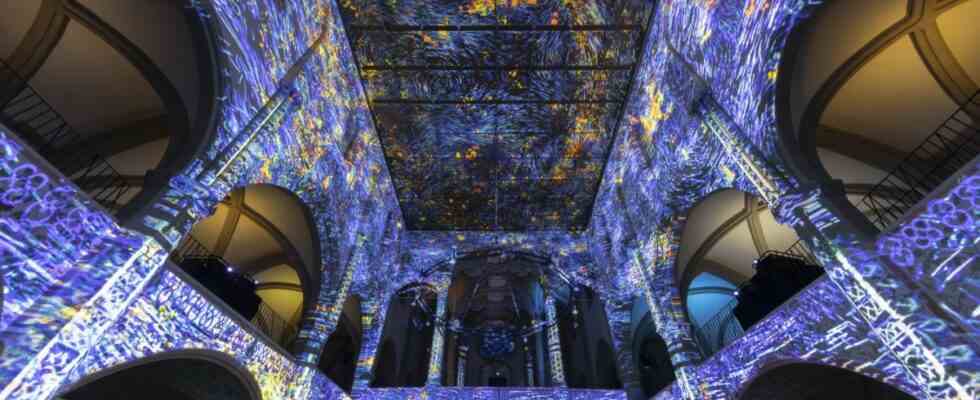Just in the midst of the Christmas hustle and bustle – lights, elbows, mulled wine – then straight into the darkness of the Ortisei church. Sacred silence surrounds you, nobody says a word. About twenty people are lying on the floor, sunk into beanbags. When you let yourself fall into one, you get the feeling of a beetle lying on its back. Struggling more or less elegantly for support, one catches the glimpse of an older lady who seems to be quite stable: “It’s unusual, but beautiful,” she encourages. Once again pushed the entire weight into the bag – won. Here we go.
It’s as if the roof is disappearing and the early Gothic columns are rising into the sky. Gustav Mahler’s “Primal Light” sounds solemnly. A white circle peels out of the black nothing, comes closer and closer and overflows with light. A shower of stars streams along the walls, envelops you completely. Everywhere it flickers and sparkles, the sky opens up again and you whizz on into the next world.
Light, water, earth, plants – these are the four spheres into which the Swiss artist collective falls projectile until January 15th in the St. Ulrich church in Regensburg. The 30-minute light installation “Genesis I” tells the first three days of the creation story, a project that was performed in Zurich in 2018 and can now be seen in Regensburg on the initiative of the diocese – for the first time in Germany (on January 20th the Show to Munich). A ticket costs twelve euros.
The Swiss around Roman Beranek actually do what the 43-year-old with the black hipster cap calls “edutainment”. With the help of large-scale projections, they guide you through the pictures and the lives of artists such as Claude Monet. Is it art or can it go away? They’ve had to listen to this many times. What is certain is that the artistic freedom is greatest in their light shows in churches.
They had the idea of playing in churches four years ago. Don’t get them wrong. They are “relatively normal people,” says Beranek, which means “not believers.” Houses of worship, however, have a unique architecture on which their light installations come into their own.
projectile namely, their installations are not just thrown on the wall, but with the help of a 3D scanner they nestle against the architecture like a light dress. Patterns run along the balustrades, the columns pulsate to the beat of the music or windows open up into the universe through the coffered ceiling. The theme, of course, the story of creation, is an ecclesiastical one. Under no circumstances did they want to advertise the church, says Beranek. That’s why their interpretation is very free and should appeal to all denominations, but they wanted to create something that “fits into the room”.
So far almost 30,000 spectators have come to see the light installation in the St. Ulrich church in Regensburg, which is being organized by Kulturoptimisten and the Isabelle Lesmeister Gallery.
(Photo: Uwe Moosburger/altrofoto.de)
Light, water, earth, plants – these are the four spheres that viewers can immerse themselves in.
(Photo: Uwe Moosburger/ altrofoto.de)
The spectators can make themselves more or less comfortable in beanbags.
(Photo: Uwe Moosburger/altrofoto.de)
So far almost 30,000 spectators have come to see the light installation in the St. Ulrich church in Regensburg, which is being organized by Kulturoptimisten and the Isabelle Lesmeister Gallery.
(Photo: Uwe Moosburger/altrofoto.de)
And churches have another advantage, says Beranek, even if the church sees things differently: they are mostly empty. At least if projectile she is not playing. In Zurich, when they showed Genesis for the first time, the church people could not believe their eyes when they saw hundreds of people pouring into their church. “They’ve never had so many people there,” says Beranek. And he too was overwhelmed by the reactions of some viewers. “They came out crying and hugged me,” he says.
There are no tears in the corners of Regensburg’s eyes, but the performance is sold out. According to the organizers, almost 30,000 viewers have watched the show since November. “I feel inspired,” says Ingrid Wirth-Hesse as she leaves the church. She raises both hands up, lowers them again. As if she had floated and landed again, that’s how it feels, says the 70-year-old. And those squiggles of light in the blue night reminded her of van Gogh. Light, dark, life and death, everything was there: “When I die, I want to see pictures like that.”
Her friend, Berthilde Schindler, 69, feels a “feeling of infinity”. Only in the end, these candles and lanterns floating in the firmament, were they really candles or were they rockets? You never know in this world, which was created by God and is being destroyed so consistently by man.
However, humans will probably not be created in Regensburg until next year. Because when things are going well, and it has been so far, they want to projectile perform “Genesis II” in Regensburg 2023 and thus complete the creation.

